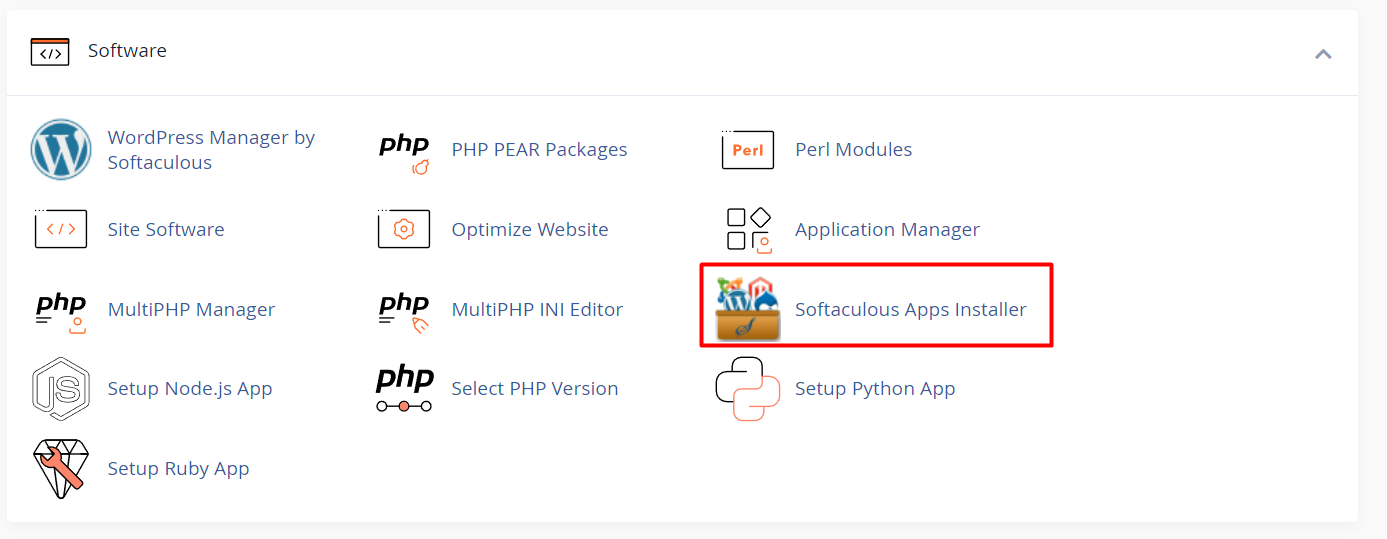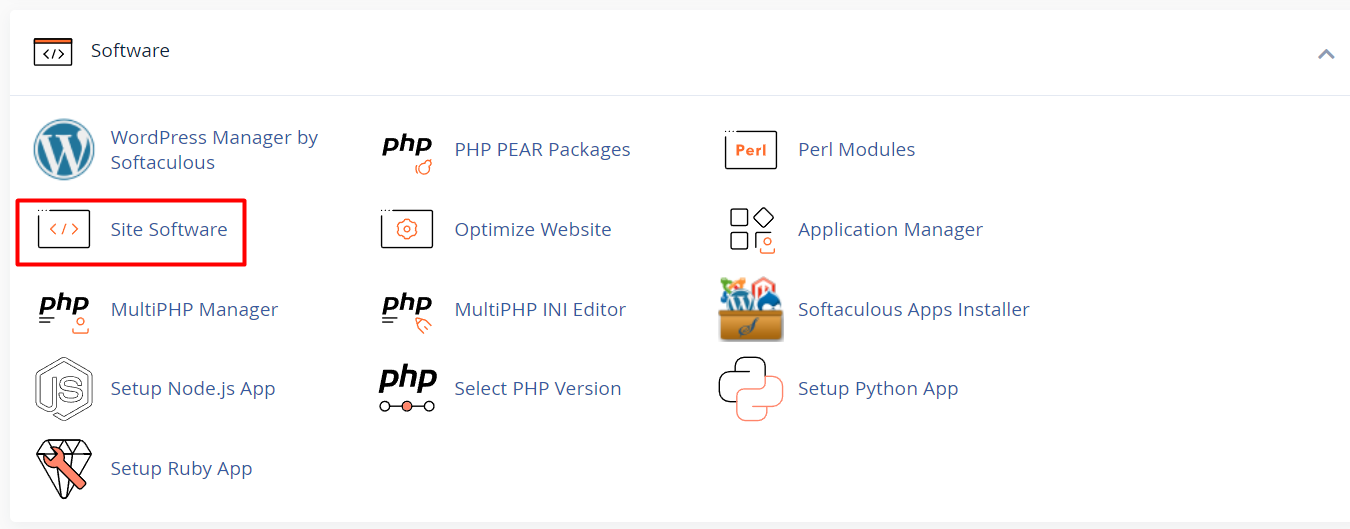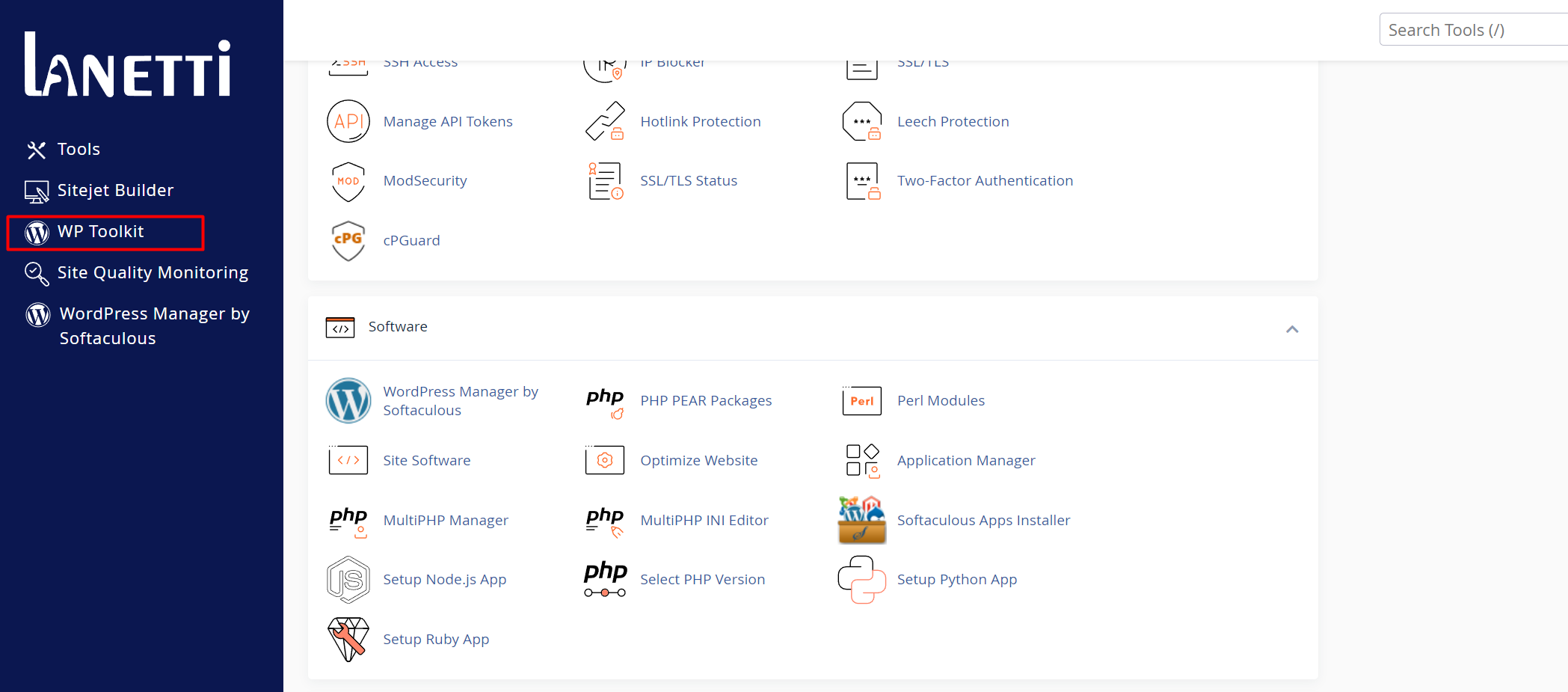Installing WordPress with cPanel: Comprehensive Guide
cPanel offers multiple ways to install WordPress, each suited to different levels of technical expertise. Below is a comprehensive guide covering the most common methods we offer.
Method 1. Using Softaculous (One-Click Installer)
Softaculous is a popular one-click installer that simplifies installing WordPress with minimal effort.
Step 1. Log in to cPanel
Step 2. Find Softaculous
Under the Software section, click on Softaculous Apps Installer.

Step 3. Select WordPress
Once in Softaculous, locate and click on the WordPress icon.

Step 4. Start the Installation
Click Install. This will take you to a form where you’ll input all necessary details.
Fill in details:
You’ll be asked to fill in details such as:
- Choose your domain (e.g., www.example.com).
- Set up your site name, admin username, password, and email.
- Choose your language and any additional plugins if required.
Click Install to begin the process. It typically completes within a few minutes.
Tip: Leave the "Directory" field empty if you want WordPress installed on the root domain (e.g., example.com instead of example.com/blog).
Step 5. Access Your WordPress Site
After installation, you’ll receive a link to log in to your WordPress admin panel.
Tip: After installation, always check that WordPress is updated to the latest version.
Advantages:
- Easy to use — ideal for beginners.
- Requires minimal setup.
- Automatically creates and configures the database.
Method 2. Manual Installation of WordPress
For users who prefer greater control or don’t have access to automatic installers, manual installation is another option.
Step 1. Download WordPress
Go to the official WordPress website and download the latest version of WordPress.
Step 2. Upload WordPress to cPanel
Go to File Manager in cPanel.

Navigate to your root directory (usually public_html).
Click Upload and select the WordPress zip file you downloaded.

Once uploaded, extract the file.
Step 3. Create a Database
In cPanel, navigate to the MySQL Databases section.
Create a new database and a database user.
Assign the user to the database, then grant All Privileges.
Write down the database name, username, and password — you’ll need them during the WordPress setup.
Step 4. Configure WordPress
Go to your domain (e.g., www.example.com).
The WordPress setup wizard will appear.
Enter your database details (database name, username, and password).
Complete the setup, adding your site’s title and admin details.
Step 5. Complete the Installation
Once you’ve entered the required information, WordPress will install, and you’ll be directed to the login page.
Tip: After installation, always check that WordPress is updated to the latest version.
Advantages:
- Full control over the installation process.
- A good learning experience for those who want to understand the backend.
Method 3. Using cPanel’s Site Software
Step 1. Log in to cPanel
Step 2. Go to Site Software
Under the Software section, click on Site Software.

Step 3. Select WordPress
Look for WordPress in the list and click it.
Input Details:
- Choose your domain.
- Enter your admin username, password, and site information.
Click Install to begin the setup. cPanel will handle the rest automatically.
Note: This method may install an older version of WordPress depending on your hosting environment. Always update WordPress after installation.
Advantages:
- Simplified, with fewer steps compared to manual installation.
- Usually pre-configured for cPanel environments.
Method 4. Using WP Toolkit
If your cPanel version includes WP Toolkit, this tool makes it easier to install and manage WordPress sites. WP Toolkit is best suited for users managing multiple WordPress sites or needing advanced features like staging, backups, or plugin sets.
Note: WP Toolkit is only available in certain hosting environments (e.g., cPanel with WordPress Toolkit enabled).
Step 1. Log in to cPanel
Step 2. Find WP Toolkit
Under the WordPress section, click on WP Toolkit.

Step 3. Start the Process
Click Install to begin the WordPress installation process.
Step 4. Select Domain
Choose the domain or subdomain where you want to install WordPress.
Step 5. Customize Settings
You can adjust the admin username, password, email, and other site settings.
Alternatively, proceed with the default settings for a quicker installation.
Step 6. Start the Installation
Click Install to begin the setup. cPanel will automatically handle the rest.
WP Toolkit will install WordPress and give you access to a dashboard where you can manage your site’s features.
Tip: After installation, always check that WordPress is updated to the latest version.
Advantages:
- Streamlined management for multiple WordPress installations.
- Additional tools like staging, cloning, and security features for WordPress.
Which Method Should You Use?
- Use Softaculous if you want the easiest and fastest setup.
- Use WP Toolkit if your host supports it and you want advanced management tools.
- Use Manual Installation if you want full control or are on a host without auto-installers.
- Use Site Software if your cPanel includes this simplified option.
Each method ultimately installs the same WordPress core — the right one depends on your comfort level and hosting setup.





